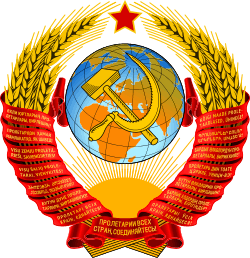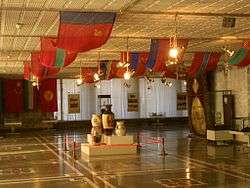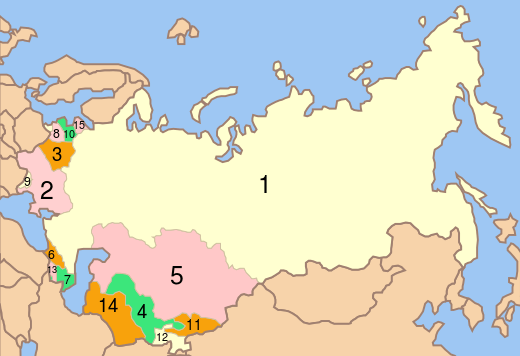Republics of the Soviet Union
| Soviet Socialist Republic | ||
|---|---|---|
|
| ||
| Category | Federated state | |
| Location | Soviet Union | |
| Created by | Treaty on the Creation of the USSR | |
| Created | 30 December 1922 | |
| Abolished by |
State Council recognition of the Baltic states independence Declaration no. 142-Н | |
| Abolished |
6 September 1991 26 December 1991 | |
| Number | 15 (as of 1989) | |
| Possible status | The Baltic republics were de jure not recognized by several countries. | |
| Populations | 1,565,662 (Estonia) – 147,386,000 (Russian SFSR) | |
| Areas | 29,800 km2 (11,500 sq mi) (Armenia) – 17,075,400 km2 (6,592,800 sq mi) (Russian SFSR) | |
| Government | Unitary Marxist-Leninist one-party socialist republics | |
| Subdivisions | Autonomous SSRs, oblasts, Autonomous oblasts, | |
| Eastern Bloc |
|---|
 |
|
Allied states |
|
Dissent and opposition 1953 uprisings
1956 protests
|
 |
| This article is part of a series on the politics and government of the Soviet Union |
|
Judiciary |
The Republics of the Soviet Union or the Union Republics (Russian: союзные республики, soyuznye respubliki) of the Soviet Union were ethnically based administrative units that were subordinated directly to the Government of the Soviet Union.[1] For most of its history, the Soviet Union was a highly centralized state; the decentralization reforms during the era of Perestroika ("Restructuring") and Glasnost ("Openness") conducted by Mikhail Gorbachev led to the dissolution of the Soviet Union in 1991.
Overview
According to Article 76 of the Constitution of the Soviet Union, a Union Republic was a sovereign Soviet socialist state that had united with other Soviet Republics in the Union of Soviet Socialist Republics. Article 81 of the Constitution stated that "the sovereign rights of Union Republics shall be safeguarded by the USSR".[2]
In the final decades of its existence, the Soviet Union officially consisted of fifteen Soviet Socialist Republics (SSRs). All of them, with the exception of the Russian Federation (until 1990), had their own local party chapters of the All-Union Communist Party.
Outside the territory of the Russian Federation, the republics were constituted mostly in lands that had formerly belonged to the Russian Empire and had been acquired by it between the 1700 Great Northern War and the Anglo-Russian Convention of 1907.
In 1944, amendments to the All-Union Constitution allowed for separate branches of the Red Army for each Soviet Republic. They also allowed for Republic-level commissariats for foreign affairs and defense, allowing them to be recognized as de jure independent states in international law. This allowed for two Soviet Republics, Ukraine and Byelorussia, (as well as the USSR as a whole) to join the United Nations General Assembly as founding members in 1945.[3][4][5]
All of the former Republics of the Union are now independent countries, with eleven of them (all except the Baltic states and Georgia) being very loosely organized under the heading of the Commonwealth of Independent States.
However, most of the international community did not consider the Baltic countries (Lithuania, Latvia, and Estonia) to have legitimately been part of the USSR. The Baltic states assert that their incorporation into the Soviet Union in 1940 (as the Lithuanian, Latvian, and Estonian SSRs) under the provisions of the 1939 Molotov–Ribbentrop Pact was illegal, and that they therefore remained independent countries under Soviet occupation.[6][7] Their position is supported by the European Union,[8] the European Court of Human Rights,[9] the United Nations Human Rights Council[10] and the United States.[11] In contrast, the Russian government and state officials maintain that the Soviet annexation of the Baltic states was legitimate.[12]
Constitutionally, the Soviet Union was a federation. In accordance with provisions present in the Constitution (versions adopted in 1924, 1936 and 1977), each republic retained the right to secede from the USSR. Throughout the Cold War, this right was widely considered to be meaningless; however, the corresponding Article 72 of the 1977 Constitution was used in December 1991 to effectively dissolve the Soviet Union, when Russia, Ukraine, and Belarus seceded from the Union.
In practice, the USSR was a highly centralised entity from its creation in 1922 until the mid-1980s when political forces unleashed by reforms undertaken by Mikhail Gorbachev resulted in the loosening of central control and its ultimate dissolution. Under the constitution adopted in 1936 and modified along the way until October 1977, the political foundation of the Soviet Union was formed by the Soviets (Councils) of People's Deputies. These existed at all levels of the administrative hierarchy, with the Soviet Union as a whole under the nominal control of the Supreme Soviet of the USSR, located in Moscow within the Russian Federation.
Along with the state administrative hierarchy, there existed a parallel structure of party organizations, which allowed the Politburo to exercise large amounts of control over the republics. State administrative organs took direction from the parallel party organs, and appointments of all party and state officials required approval of the central organs of the party.
Each republic had its own unique set of state symbols: a flag, a coat of arms, and, with the exception of Russia until 1990, an anthem. Every republic of the Soviet Union also was awarded with the Order of Lenin.

Union Republics of the Soviet Union
Number of the union republics of the USSR varied from 4 to 16. In majority of years and at the later decades of its existence, the Soviet Union consisted of 15 Soviet Socialist Republics. Rather than listing the republics in alphabethical order, the republics were listed in constitutional order, which, particularly by the last decades of the Soviet Union, did not correspond to order either by population or economic power.
 Map of the Union Republics from 1956-1991 | |||||||||||||||
|---|---|---|---|---|---|---|---|---|---|---|---|---|---|---|---|
| Soviet Socialist Republic | Continent | Capital | Titular nationality | Member from |
Population (1989) |
Pop./USSR pop. (%) |
Area (km²) (1991) |
Area/USSR area (%) |
Independent state |
No. | |||||
| (Российская Советская Федеративная Социалистическая Республика) |
Europe / Asia | Moscow | Russian | 1922 | 147,386,000 | 51.40 | 17,075,400 | 76.62 | |
1 | |||||
| (Украї́нська Радя́нська Соціалісти́чна Респу́бліка) |
Europe | Kiev (Kharkiv before 1934) |
Ukrainian | 1922 | 51,706,746 | 18.03 | 603,700 | 2.71 | |
2 | |||||
| (Белару́ская Саве́цкая Сацыялісты́чная Рэспу́бліка) |
Europe | Minsk | Belarusian | 1922 | 10,151,806 | 3.54 | 207,600 | 0.93 | |
3 | |||||
| (Ўзбекистон Совет Социалистик Республикаси) (Oʻzbekiston Sovet Sotsialistik Respublikasi') |
Asia | Tashkent (Samarkand before 1930) |
Uzbek | 1924 | 19,906,000 | 6.94 | 447,400 | 2.01 | |
4 | |||||
| (Қазақ Кеңестік Социалистік Республикасы) |
Europe / Asia | Alma-Ata | Kazakh | 1936 | 16,711,900 | 5.83 | 2,717,300 | 12.24 | |
5 | |||||
| (საქართველოს საბჭოთა სოციალისტური რესპუბლიკა) |
Europe / Asia | Tbilisi | Georgian | 1922 | 5,400,841 | 1.88 | 69,700 | 0.31 | |
6 | |||||
| (Азәрбајҹан Совет Сосиалист Республикасы (Azərbaycan Sovet Sosialist Respublikası) |
Europe / Asia | Baku | Azerbaijani | 1922 | 7,037,900 | 2.45 | 86,600 | 0.39 | |
7 | |||||
| (Lietuvos Tarybų Socialistinė Respublika) |
Europe | Vilnius | Lithuanian | 1940 | 3,689,779 | 1.29 | 65,200 | 0.29 | |
8 | |||||
| (Република Советикэ Сочиалистэ Молдовеняскэ) (Republica Sovietică Socialistă Moldovenească) |
Europe | Kishinev | Moldovan | 1940 | 4,337,600 | 1.51 | 33,843 | 0.15 | |
9 | |||||
| (Latvijas Padomju Sociālistiskā Republika) |
Europe | Riga | Latvian | 1940 | 2,666,567 | 0.93 | 64,589 | 0.29 | |
10 | |||||
| (Кыргыз Советтик Социалисттик Республикасы) |
Asia | Frunze | Kyrgyz | 1936 | 4,257,800 | 1.48 | 198,500 | 0.89 | |
11 | |||||
| (Республикаи Советии Социалистии Тоҷикистон) |
Asia | Dushanbe | Tajik | 1929 | 5,112,000 | 1.78 | 143,100 | 0.64 | |
12 | |||||
| (Հայկական Սովետական Սոցիալիստական Հանրապետություն) |
Europe / Asia | Yerevan | Armenian | 1922 | 3,287,700 | 1.15 | 29,800 | 0.13 | |
13 | |||||
| (Түркменистан Совет Социалистик Республикасы) (Türkmenistan Sowet Sotsialistik Respublikasy) |
Asia | Ashkhabad | Turkmen | 1924 | 3,522,700 | 1.23 | 488,100 | 2.19 | |
14 | |||||
| (Eesti Nõukogude Sotsialistlik Vabariik) |
Europe | Tallinn | Estonian | 1940 | 1,565,662 | 0.55 | 45,226 | 0.20 | |
15 | |||||
^a The annexation of the Baltic republics in 1940 is considered an illegal occupation by the current Baltic governments and by a number of Western countries, including the United States and the European Union.[6][8][9][10][11][13][14][15] The Soviet Union considered the initial annexation legal, but officially recognized their independence on September 6, 1991, three months prior to its final dissolution.
Former Union Republics of the Soviet Union
- The Transcaucasian SFSR was formed from the Armenian, Azerbaijan and Georgian SSRs. It was divided back to the three SSRs in 1936.
- The Karelo-Finnish SSR (1940–1956) was restored to the Karelian Autonomous Soviet Socialist Republic which belonged to the Russian SFSR. Its successor state is the Republic of Karelia within the Russian Federation.
Other Soviet republics
- The Socialist Soviet Republic of Byelorussia, in winter of 1919
- The Lithuanian–Byelorussian Soviet Socialist Republic was proclaimed in 1919 but fell very soon.
- The Galician Soviet Socialist Republic
- The Donetsk–Krivoy Rog Soviet Republic
- The Don Soviet Republic
- The Kuban Soviet Republic
- The Kuban-Black Sea Soviet Republic
- The Latvian Socialist Soviet Republic
- The Lithuanian Soviet Socialist Republic (1918–19)
- The Mughan Soviet Republic
- The Soviet Republic of Naissaar
- The Odessa Soviet Republic
- The North Caucasian Soviet Republic
- The Stavropol Soviet Republic
- The Taurida Soviet Socialist Republic
- The Terek Soviet Republic
- The Ukrainian People's Republic of Soviets
- The Ukrainian Soviet Republic
- The Black Sea Soviet Republic
- The Far Eastern Republic existed in 1920-1922 as formally independent state being at Soviet control de facto.
- The Abkhazian SSR, soon after its establishment in 1921, belonged as a contractual republic to the Georgian SSR and by extension to the Transcaucasian SFSR in 1922. Its status was changed to an autonomous SSR of the Georgian SSR in 1931. It is now the breakaway Republic of Abkhazia, which is not recognized by Georgia or most of the international community.
- The Khorezm People's Soviet Republic (later SSR) (1923–1925) was divided between the Turkmen and Uzbek SSRs.
- The Bukharan People's Soviet Republic (later SSR) (1924–1925) was divided between the Tajik, Uzbek, and Turkmen SSRs.
- The Persian Socialist Soviet Republic, in what is now Iran.
The Turkestan Soviet Federative Republic was proclaimed in 1918 but did not survive to the founding of the USSR, becoming the short-lived Turkestan Autonomous Soviet Socialist Republic of the RSFSR. The Crimean Soviet Socialist Republic (Soviet Socialist Republic of Taurida) was also proclaimed in 1918, but did not became a union republic and was made into an autonomous republic of the RSFSR, although the Crimean Tatars had a relative majority until the 1930s or 1940s according to censuses. When the Tuvan People's Republic joined the Soviet Union in 1944, it did not become a union republic, and was instead established as an autonomous republic of the RSFSR.
The leader of the People's Republic of Bulgaria, Todor Zhivkov, suggested in the early 1960s that the country should become a union republic, but the offer was rejected.[16][17][18]
Unrealized Soviet states
Workers' communes
- The Volga Germans Workers' Commune
- The Estland Workers' Commune
- The Karelian Workers' Commune
- The Petrograd Workers' Commune, later the Northern Oblast Communes Association
Autonomous Republics of the Soviet Union
Several of the Union Republics themselves, most notably Russia, were further subdivided into Autonomous Soviet Socialist Republics (ASSRs). Though administratively part of their respective Union Republics, ASSRs were also established based on ethnic/cultural lines.
The republics at the dissolution of the Soviet Union
Under Mikhail Gorbachev, openness and restructuring were intended to liberalise and open up the Soviet Union. However, they had a number of effects which caused the power of the republics to increase. First, political liberalization allowed the governments within the republics to gain legitimacy by invoking democracy, nationalism, or a combination of both. In addition, liberalization led to fractures within the Communist Party which resulted in reduced ability to effectively govern the Union. The rise of nationalist and right-wing movements, notably led in Russia by Boris Yeltsin, in the previously homogeneously Communist political system led to the crumbling of the Union's foundations. With the central role of the Communist Party removed from the constitution, the Communist Party lost its control over the political system and was banned from operating after an attempted coup d'état.
Throughout the unravelling of the Restructuring, the Soviet government attempted to find a new structure which would reflect the increasing power of the republics. Some autonomous republics, like Tatarstan, Checheno-Ingushetia, Abkhazia, South Ossetia, Crimea, Transnistria, Gagauzia sought the union statute in New Union Treaty. Efforts of foundation of Union of Sovereign States proved unsuccessful and the republics began to secede from the Union. By 6 September 1991, the Soviet Union's State Council recognized the independence of Estonia, Latvia and Lithuania bringing the number of union republics down to 12. On 8 December 1991, the remaining republic leaders signed the Belavezha Accords which agreed that the USSR would be dissolved and replaced with a Commonwealth of Independent States. On 25 December, President Gorbachev announced his resignation and turned all executive powers over to Yeltsin. The next day the Council of Republics voted to dissolve the Union. Since then, the republics have been governed independently with some adopting significantly more liberal policies while others, particularly in Central Asia, retain leadership personnel from the Soviet time to this day.
See also
- National delimitation in the Soviet Union
- Bavarian Soviet Republic
- Hungarian Soviet Republic
- Slovak Soviet Republic
- Paris Commune
- Provisional Polish Revolutionary Committee (Polish SSR)
- Republics of Russia
- Federal subjects of Russia
References
- ↑ Hough, Jerry F (1997). Democratization and revolution in the USSR, 1985-1991. Brookings Institution Press. ISBN 0-8157-3749-1.
- ↑ Federalism and the Dictatorship of Power in Russia By Mikhail Stoliarov. Taylor & Francis. 2014. p. 56. ISBN 0-415-30153-X. Retrieved 2014-02-18.
- ↑ "Walter Duranty Explains Changes In Soviet Constitution,". Miami News. News.google.com. 1944-02-06. Retrieved 2014-02-18.
- ↑ "League of Nations Timeline - Chronology 1944". Indiana.edu. Retrieved 2014-02-18.
- ↑ "United Nations - Founding Members". Un.org. Retrieved 2014-02-18.
- 1 2 The Occupation of Latvia at Ministry of Foreign Affairs of the Republic of Latvia
- ↑ Estonia says Soviet occupation justifies it staying away from Moscow celebrations - Pravda.Ru
- 1 2 Motion for a resolution on the Situation in Estonia by the EU
- 1 2 European Court of Human Rights cases on Occupation of Baltic States
- 1 2 "UNITED NATIONS Human Rights Council Report". Ap.ohchr.org. Retrieved 2014-02-18.
- 1 2 "U.S.-Baltic Relations: Celebrating 85 Years of Friendship" (PDF). U.S. Department of State. 14 June 2007. Retrieved 29 July 2009.
- ↑ Russia denies Baltic 'occupation' by BBC News
- ↑ European parliament: Resolution on the situation in Estonia, Latvia and Lithuania (No C 42/78) (1983). Official Journal of the European Communities. European Parliament.
- ↑ Aust, Anthony (2005). Handbook of International Law. Cambridge University Press. ISBN 978-0-521-53034-7.
- ↑ Ziemele, Ineta (2005). State Continuity and Nationality: The Baltic States and Russia. Martinus Nijhoff Publishers. ISBN 90-04-14295-9.
- ↑ Elster, Jon (1996). The roundtable talks and the breakdown of communism. University of Chicago Press. p. 179. ISBN 0-226-20628-9.
- ↑ Held, Joseph (1994). Dictionary of East European history since 1945. Greenwood Press. p. 84. ISBN 0-313-26519-4.
- ↑ Gökay, Bülent (2001). Eastern Europe since 1970. Longman. p. 19. ISBN 0-582-32858-6.

